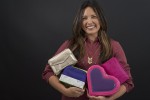Kyrra Richards hid her secret in a stark, black nylon pouch. The bleak container was filled with lancet needles, syringes and insulin pumps: evidence of the Type 1 diabetes she tried to conceal from friends, agents and casting directors.
The UCLA alumna, who has no family history of the disease, said she was ashamed to admit she had diabetes when she was first diagnosed in 2008. At the time, 24-year-old Richards was pursuing a professional career as a commercial dancer and model on Nickelodeon, Fox Sports, BET and the Kids’ Choice Awards. When she was at UCLA until 2005, Richards was a three-time captain of the dance team.
“It was really scary being told you have diabetes when your entire being and your entire professional career is reliant on being physically healthy,” Richards said.
Richards said when she was first diagnosed, her initial weight fluctuations caused her to miss out on dancing and modeling opportunities. Few professions outside of entertainment require the same scrutiny of having to turn slowly before casting agents as they inspect every physical imperfection, she added.
“It was tearfully frustrating trying to figure out my body with diabetes,” Richards said.
To cope with her diagnosis, Richards created Myabetic, a company that makes fashionable cases for storing medical supplies such as glucose meters, test strips and syringes for people with diabetes. Now sold at Target stores nationwide, the cases’ designs are all based on images of her favorite things, she said, and her favorite is a purple butterfly-shaped purse she calls the Love Bug.
“Truthfully I felt ugly with diabetes,” Richards said. “I had to feel like there was something that made it attractive for me to manage my health.”
The alumna said she was initially unprepared for the symptoms of her diagnosis: the constant dehydration, fluctuating energy levels and overall exhaustion. The exertion eventually forced her to put a pause on her dancing, adding to her frustration that the disease had stolen her career, she said.
Turning her professional focus toward business, Richards said Myabetic began as a collection of her own drawings and designs for products she would feel happy displaying for her diabetes equipment.
To translate her designs from paper to products, Richards said she reached out to her friend and UCLA alumna Lauren Ziminsky. Ziminsky said when she was approached to help with the startup, she leapt at the opportunity to work professionally with Richards, adding that Richards had established herself as a reliable collaborator at UCLA in the dance major.
Abner Shao, who had captained UCLA’s spirit squad while Richards led the dance team, said while Richards’ diabetes diagnosis came as a shock, he was not surprised to hear of the entrepreneurial twist she spun out of her situation. He added that at UCLA, Richards always had plans to open her own dance studio.
“She’s always been an entrepreneur and creative spirit at heart,” Shao said. “Now she’s just doing it with cases instead of choreography.”
Richards said the goal of Myabetic is to beautify the process of managing diabetes because coping with the disease is a full-time job. She said she pricks her finger six to 10 times a day to check her blood sugar and plans her days around trying to maintain stability.
What hurt more than the finger pricks was the stigma she faced as a young person diagnosed with diabetes, Richards said. Though her Type 1 diagnosis is a genetic disorder resulting from unpreventable pancreatic failure, she said only a few people recognize the blameless cause of the illness.
Shao said he was shocked when he first learned that Richards had diabetes because he had always known Richards to be physically fit and a conscious eater, picking extra toppings off her sandwiches and asking for light dressing on everything she ordered. It was not until he learned more about Type 1 diabetes from Richards that he said he realized there was actually no correlation between lifestyle and diagnosis.
“People think you get Type 1 diabetes because you ate this or drank that,” Richards said. “Everyone has a theory of what you did wrong to get Type 1 diabetes.”
Now that Richards has been managing diabetes for eight years, the 33-year-old said she has returned to the dance world by teaching and judging competitions on the side, even though her professional focus is still with Myabetic. Her diagnosis of diabetes eventually helped her find balance between her creative and professional needs.
“I used to think there was creativity and art, and then there was business as this rigid, cold other thing,” Richards said. “But with Myabetic, I can still be expressive: I’m making art within the business and medical space.”
